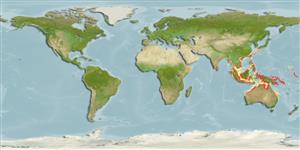Environment: milieu / climate zone / depth range / distribution range
Ökologie
seewasser; brackwasser demersal. Tropical
Indo-West Pacific: South and southeast Asia, southern New Guinea and northern Australia.
Size / Gewicht / Alter
Maturity: Lm ? range ? - ? cm
Max length : 50.0 cm TL Männchen/unbestimmt; (Ref. 58022)
Rückenflossenstacheln (insgesamt) : 1; Afterflossenstacheln: 0; Afterflossenweichstrahlen: 14 - 21. Head depressed and elongate, 27 - 36% (mean 32%) of SL; exposed shield very striate or sharply granular. Narrow supraoccipital process, always keeled. Low set eyes. Small mouth, width 24 - 40% (mean 31%) of HL. Gill rakers absent on hind aspect of first 2 gill arches. Posterior epithelial ridges of palate run transversely. Caudal peduncle depth, 1.3 - 2.1 in its length (Ref. 38478).
Occurs in inshore waters over soft bottoms (Ref. 7300). Feeds on detritus, prawns, soft-bodied organisms, and mud (Ref. 38478).
Life cycle and mating behavior
Maturities | Fortpflanzung | Spawnings | Egg(s) | Fecundities | Larven
Marceniuk, A.P. and N.A. Menezes, 2007. Systematics of the family Ariidae (Ostariophysi, Siluriformes), with a redefinition of the genera. Zootaxa 1416:1-126. (Ref. 58022)
IUCN Rote Liste Status (Ref. 130435)
Bedrohung für Menschen
Traumatogenic (Ref. 58010)
Nutzung durch Menschen
Tools
Zusatzinformationen
Download XML
Internet Quellen
Estimates based on models
Preferred temperature (Ref.
123201): 25.6 - 29.1, mean 28.3 °C (based on 1122 cells).
Phylogenetic diversity index (Ref.
82804): PD
50 = 0.5039 [Uniqueness, from 0.5 = low to 2.0 = high].
Bayesian length-weight: a=0.00525 (0.00269 - 0.01023), b=3.11 (2.94 - 3.28), in cm total length, based on LWR estimates for this (Sub)family-body shape (Ref.
93245).
Trophic level (Ref.
69278): 3.8 ±0.2 se; based on diet studies.
Widerstandsfähigkeit (Ref.
120179): mittel, Verdopplung der Population dauert 1,4 - 4,4 Jahre. (Preliminary K or Fecundity.).
Fishing Vulnerability (Ref.
59153): Moderate vulnerability (40 of 100).
